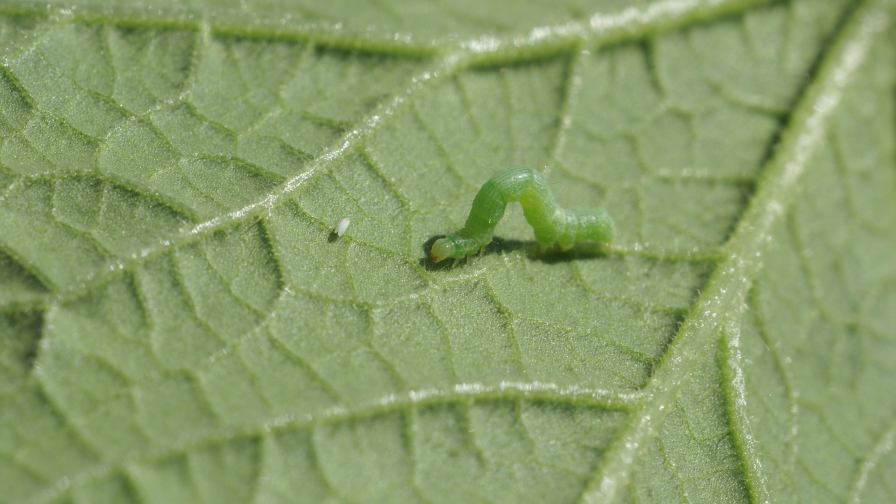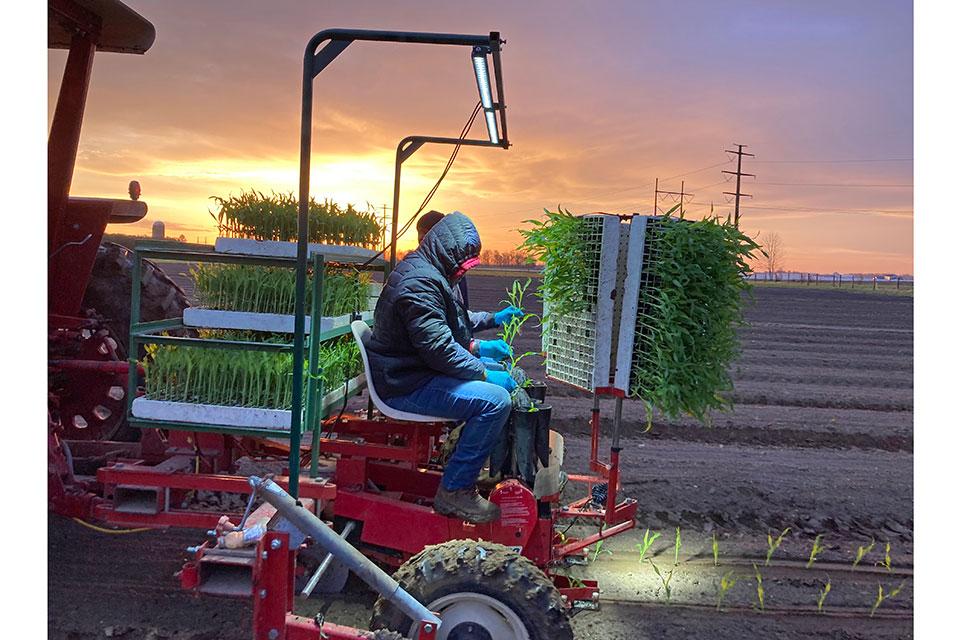Take Control Of Your Melon Pests
As cool, wet weather conditions persisted in the Southwest through the winter months, and in spite of the predicted El Niño conditions never fully materializing, melon growers face the challenge of managing key pests.
According to John Palumbo, Research and Extension Specialist from the Department of Entomology at the University of Arizona, seed corn maggot has risen to the top of the list of concerns for growers in the region, followed by sweet potato whiteflies, and the Lepidoptera pests beet armyworm and cabbage looper.
Palumbo provides general management tips for the pests, and answers questions related to symptoms and scouting, as well as chemical and cultural controls.
What type of insect pressure is anticipated for the Southwest this spring?

Cabbage looper larvae are annual threats to cantaloupes and watermelons. Once fruit begin to set, larvae can be found on the outer surface of developing and mature fruit. Photo by John Palumbo
Palumbo: It is always hard to predict what insect pressure will be like in the spring because weather can have a significant influence on insect abundance. Thus far this winter, temperatures have been fairly cold — at least for the desert — but observations to this point suggest that we’re not seeing significant overwintering mortality of our key pests that will ultimately migrate into melons. However, we are having a wet winter and this can significantly influence population abundance of some insects.
Fall populations of whiteflies and Lepidoptera pests were lower as opposed to previous years, and if temperatures remain cooler than normal this spring, infestations could be similarly low. However, cool wet weather favors abundance of seed corn maggots, so given our current conditions and the forecast of an extended El Niño, melon growers should definitely be preparing for a heavy maggot year.
Which three insect pests are at the top of your list for the coming season?
Palumbo: Seed corn maggot is always a concern for melons planted from January through March, but may be a more important pest this year because of the potential for more cool, wet weather.
Sweet potato whiteflies are an important threat to spring melons every year. Thus far, we have not observed high levels of overwintering mortality. Adults and immatures can currently be found on winter vegetable crops at sub-economic levels throughout the region. As temperatures gradually increase, adults will begin to move into spring melons and can rapidly build up as the weather turns hot.
Similarly, Lepidoptera pests (such as beet armyworm and cabbage looper) are annual threats to cantaloupes and watermelons, typically showing up on crops during fruit set.
What are the main symptoms of each insect infestation?
Palumbo: The symptoms of damage vary with each pest so it is important to check stand emergence and plant leaves.
Seed corn maggot attacks germinating seeds and transplant plugs, so damage is often evident by poor stand emergence or wilting transplants in the field. Once seed corn maggot larvae are found in planted or transplanted fields, there is no economic approach for their control, so growers must use a preventive approach.
Sweet potato whitefly adults and large nymphs can easily be found on the undersides of leaves. However, eggs and small nymphs may require a hand lens. If nymphs are allowed to infest plants, plant growth can be significantly reduced.
Initially, Lepidoptera (beet armyworm and cabbage looper) larval activity is evident from damage to older leaves resulting from leaf feeding. Once fruit begin to set, larvae can be found feeding on the outer surface of developing and mature fruit.
When should scouting begin for each insect?
Palumbo: For some pests, scouting isn’t an option. For others, you need
to pay attention to the weather.
You really can’t scout for seed corn maggot. If a grower is planting into a field that contains a lot of plant residue from the previous crop, he is almost assured to have maggot pressure. Either way, growers need to apply prophylactic treatments to early (January-February) planted fields to ensure a quality stand.
Once plant vines begin to run and temperatures are consistently warm, pest control advisors (PCAs) should begin to examine the under-sides of leaves near the terminal for the presence of whitefly adults. If more than 50% of leaves contain at least three adults, then growers should consider treating.
Lepidoptera sampling should begin early in plant growth for the presence of leaf damage. When plants begin to fruit, PCAs should begin examining developing fruit for the presence of larvae and fresh feeding signs.
What are the chemical controls that can be used for each insect?
Palumbo: Several products are available. It’s important to pay attention to the timing of the application. The standard seed corn maggot approach in the desert Southwest is to apply a pyrethroid insecticide —
for example Capture LFR (FMC Corp.) or Athena (FMC Corp.) — in-furrow at planting, or as a transplant drench to prevent maggots from damaging germinating seeds and feeding on transplant plugs.
Growers can apply imidacloprid or thiamethoxam at planting and this will provide 45% to 60% sweet potato whitefly control. If additional control of nymphs is required before harvest, growers can apply insect growth regulators, such as Vetica (Nichino America), Courier (Nichino America), Knack (Valent), or Oberon (Bayer CropScience) that should provide residual control during harvest. Foliar options for adult knockdown include Venom (Valent), Scorpion (Gowan), Assail (United Phosphorus, Inc.), Exirel (DuPont), and Sivanto (Bayer CropScience).
There are a number of products available that provide excellent control of both cabbage loopers and beet armyworms on melons including Radiant (Dow AgroSciences), Coragen (DuPont), Exirel, Vetica, Belt (Bayer CropScience), Intrepid (Dow AgroSciences), and Voliam Xpress (Syngenta). Exirel and Vetica will also provide activity against sweet potato whiteflies.
What are the cultural controls for each insect?
Palumbo: There are a variety of cultural controls growers should follow from disking crop residue to sanitation.
Seed corn maggot: To avoiding maggot problems, incorporation of previous crop residues by disking or plowing well in advance of planting helps to reduce the attractiveness of the field to ovipositing flies. This also includes good incorporation of organic fertilizer, and composted manures.
Avoid, when possible, direct seeding or transplanting melons following cole crops or lettuce fields that were lightly harvested and excessive plant residue remains in the field. This, along with cool, wet weather provides an attractive habitat for maggots.
Sweet potato whiteflies: Careful consideration of crop sequencing, crop placement, and planting dates can have significant impacts on adult sweet potato whitefly migration onto spring melons. Early planting of spring melons and uniformity of planting in an area can reduce the impact of sweet potato whitefly as well.
Sanitation and clean culture are perhaps the most important cultural practices that can be employed on an area-wide basis. Rapid postharvest destruction of winter vegetable crops can reduce the magnitude and duration of whitefly movement in an area. It is also important to eliminate weed hosts in and around fields to be planted, particularly in the winter where they can serve as overwintering reservoirs for sweet potato whitefly and viruses.
Lepidoptera: (beet armyworm and cabbage looper): Cultural controls can help suppress Lepidoptera populations over time and space. Disk produce fields adjacent to melons immediately following harvest to kill larvae and pupae.
Sanitation along field borders is important. Beet armyworms often migrate from weedy field edges into newly planted fields. Cantaloupe and watermelon transplants should be inspected carefully for larvae and other pests before transplanting.
What can growers do to reduce the incidence of an insect infestation and get a jump on protecting their melon crops in the coming season?
Palumbo: For all pests it is important to utilize optimal growing practices to avoid stressing newly emerged seedlings. This would include proper preparation of seedbeds and management of irrigation, plant nutrition, and salinity.
Experience has shown that a vigorously growing plant with a strong root system is better able to withstand external stresses like whiteflies and Lepidoptera when temperatures get hot in May and June, and plants have a full fruit load. Any additional stresses can delay growth and affect yield potential.









